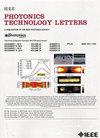Bandwidth Characteristics of a Graphene/Silicon Schottky-Junction Photodetector
IF 2.3
3区 工程技术
Q2 ENGINEERING, ELECTRICAL & ELECTRONIC
引用次数: 0
Abstract
Graphene/silicon (Gr/Si) heterostructure has emerged as a promising approach for high-performance broadband photodetectors. However, it is often the case that devices of similar structures exhibit bandwidths that differ by orders of magnitude. Moreover, the relatively large photosensitive area combined with multiple operation modes make it imperative to understand the in-plane bandwidth characteristics of such devices. Here, we conducted a thorough investigation of the in-plane bandwidth distribution and the focal-condition-dependent bandwidth characteristics in an exemplar Gr/Si Schottky-junction photodetector with a large lateral dimension (石墨烯/硅肖特基结光电探测器的带宽特性
石墨烯/硅(Gr/Si)异质结构已成为高性能宽带光电探测器的一种很有前途的方法。然而,通常情况下,类似结构的器件表现出不同数量级的带宽。此外,相对较大的光敏面积加上多种工作模式,使得了解此类器件的面内带宽特性势在必行。在此,我们对一个典型的横向尺寸为$\sim 640~\mu $ m的Gr/Si schottkey结光电探测器的平面内带宽分布和与聚焦条件相关的带宽特性进行了深入的研究,发现用0.35/ $\tau _{\mathrm {FWHM}}$方法推导出的带宽比传统的S21带宽更能描述器件的高频瞬态响应。此外,还研究了光照面积和激励功率密度对响应时间的影响。我们的研究有助于澄清两种常用的带宽值,并建议对平面内带宽特性进行更多的分析,可能会导致更新光敏器件的设计指南。
本文章由计算机程序翻译,如有差异,请以英文原文为准。
求助全文
约1分钟内获得全文
求助全文
来源期刊

IEEE Photonics Technology Letters
工程技术-工程:电子与电气
CiteScore
5.00
自引率
3.80%
发文量
404
审稿时长
2.0 months
期刊介绍:
IEEE Photonics Technology Letters addresses all aspects of the IEEE Photonics Society Constitutional Field of Interest with emphasis on photonic/lightwave components and applications, laser physics and systems and laser/electro-optics technology. Examples of subject areas for the above areas of concentration are integrated optic and optoelectronic devices, high-power laser arrays (e.g. diode, CO2), free electron lasers, solid, state lasers, laser materials'' interactions and femtosecond laser techniques. The letters journal publishes engineering, applied physics and physics oriented papers. Emphasis is on rapid publication of timely manuscripts. A goal is to provide a focal point of quality engineering-oriented papers in the electro-optics field not found in other rapid-publication journals.
 求助内容:
求助内容: 应助结果提醒方式:
应助结果提醒方式:


